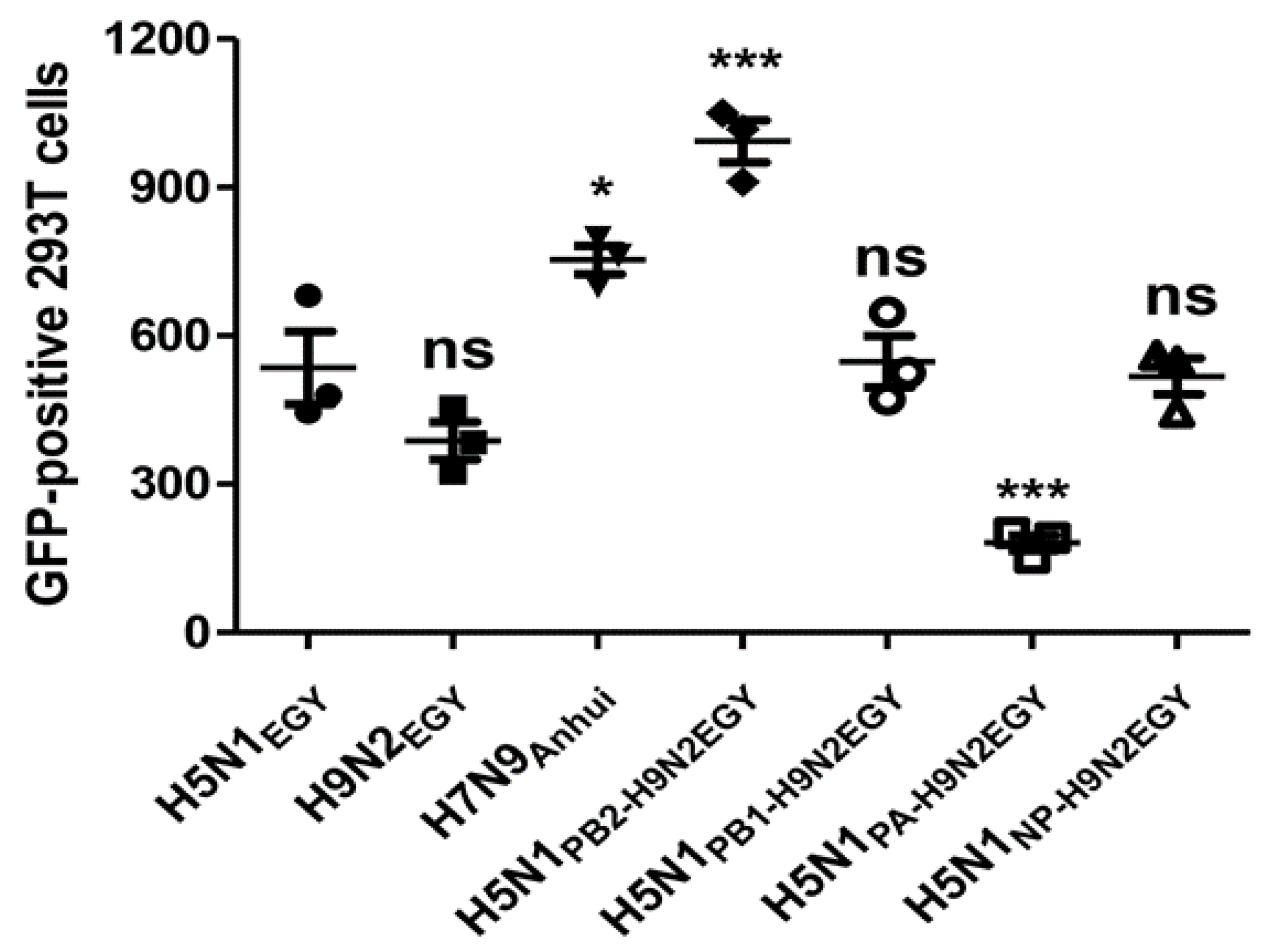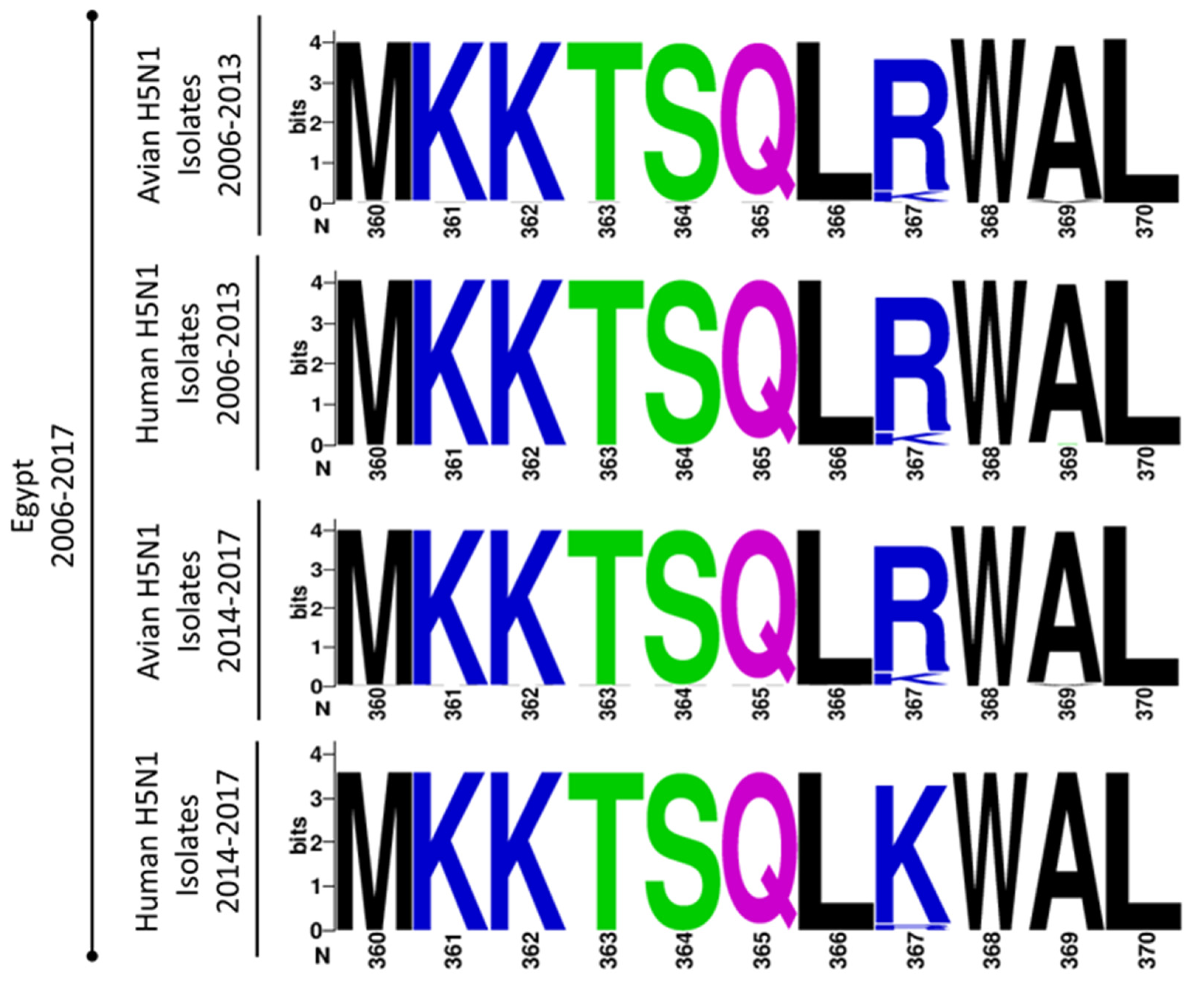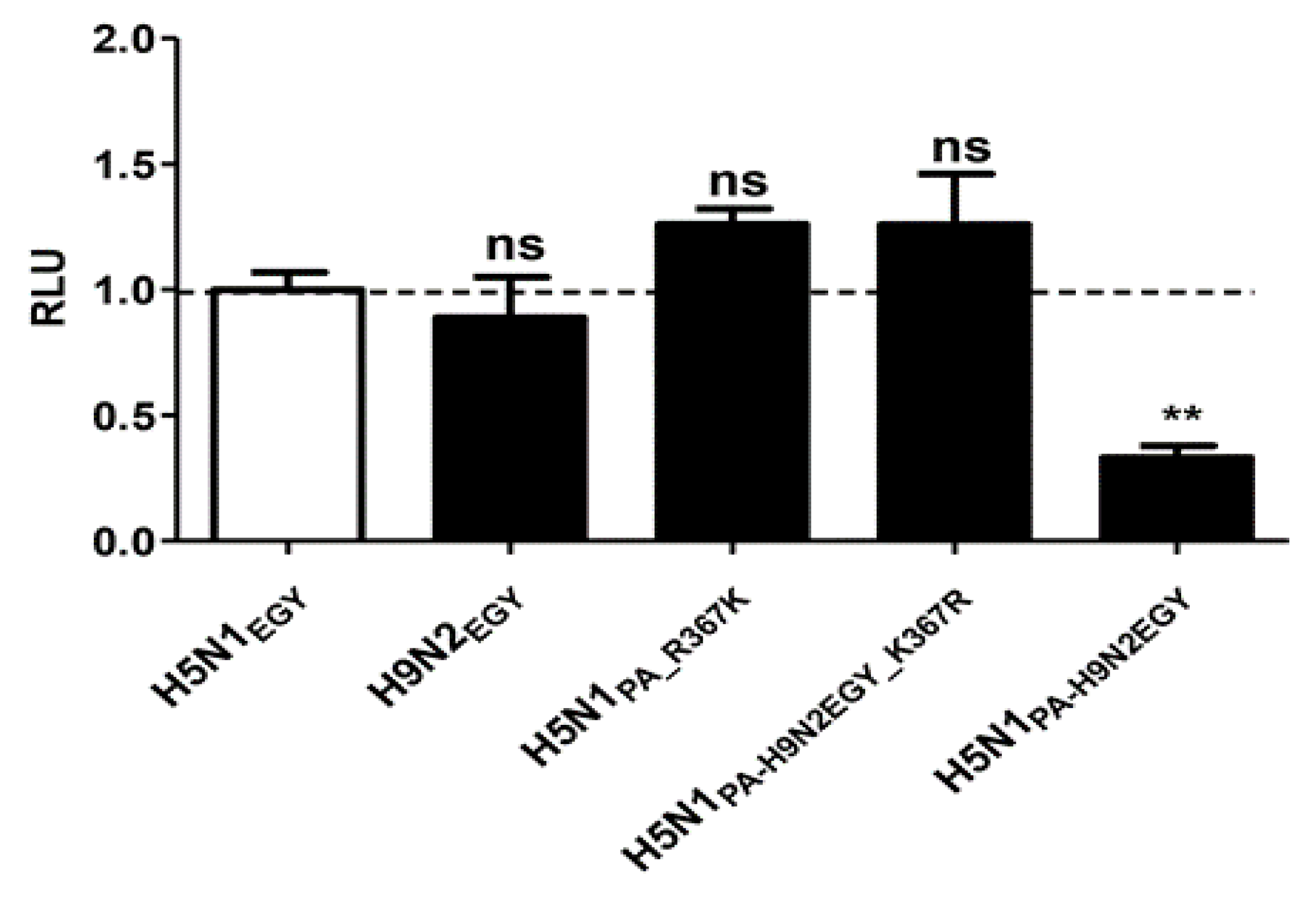PA from a Recent H9N2 (G1-Like) Avian Influenza A Virus (AIV) Strain Carrying Lysine 367 Confers Altered Replication Efficiency and Pathogenicity to Contemporaneous H5N1 in Mammalian Systems
Abstract
1. Introduction
2. Materials and Methods
2.1. Cells, Viruses and Plasmids
2.2. Reverse Genetics (Rg) Systems for H5N1EGY and H9N2EGY and Generation of Reassortant, Mutant and Wild-Type Strains
2.3. In Vitro Replication Efficiency of Reassortant and Wild-Type Strains
2.4. Flow Cytometry Analysis of Viral Polymerase Activity
2.5. Temperature-Dependent Replication Kinetics of Reassortant and Wild-Type Strains
2.6. Pathogenicity of Reassortant Strains versus Wild-Type H5N1EGY in BALB/c Mice
2.7. Luciferase Reporter Assay
2.8. Pathogenicity of Mutated Strains versus Wild-Type H5N1EGY in BALB/c Mice
2.9. Ethical Statement and Biosafety
2.10. Statistical Analysis
3. Results
3.1. Gene segments of H9N2EGY Show High Genetic Compatibility in the Genetic Background of H5N1EGY
3.2. Improved Replication Efficiency of H5N1EGY Reassortants Expressing PB2 and PA of H9N2EGY in MDCK-II Cells
3.3. Impact of the Polymerase Subunits of H9N2EGY on the Polymerase Activity of Reassortant H5N1EGY
3.4. Replication Efficiency of Reassortant and Wild-Type H5N1EGY in Human Lung Cells Increases at Elevated Temperature Resembling Lung Ambient Temperature in Humans
3.5. Reassortants H5N1PB2-H9N2EGY and H5N1PA-H9N2EGY Showed Similar to Lower Virulence When Compared to the Wild-Type H5N1EGY in Mice
3.6. The Genetic Analysis of the Polymerase-Encoding Segments from H9N2EGY Revealed that the PAH9N2EGY and PB2H9N2EGY Encode for Distinct Mammalian-Like Variations
3.7. The H5N1EGY Mutant Expressing PAR367K Replicates Efficiently in Primary Human Bronchial Epithelial Cells and Continuous Human Cell Culture Models in a Temperature-Dependent Manner
3.8. Replication Efficiency of H5N1PA_R367K Is Not Associated with an Enhanced Polymerase Activity
3.9. The PA_R367K Contributes to the Pathogenicity of H5N1EGY in Mice
4. Discussion
Author Contributions
Funding
Acknowledgments
Conflicts of Interest
References
- Mostafa, A.; Abdelwhab, E.M.; Mettenleiter, T.C.; Pleschka, S. Zoonotic potential of influenza a viruses: A comprehensive overview. Viruses 2018, 10, 497. [Google Scholar] [CrossRef] [PubMed]
- Saad, M.D.; Ahmed, L.S.; Gamal-Eldein, M.A.; Fouda, M.K.; Khalil, F.; Yingst, S.L.; Parker, M.A.; Montevillel, M.R. Possible avian influenza (h5n1) from migratory bird, egypt. Emerg. Infect. Dis. 2007, 13, 1120–1121. [Google Scholar] [CrossRef] [PubMed]
- Bahgat, M.M.; Kutkat, M.A.; Nasraa, M.H.; Mostafa, A.; Webby, R.; Bahgat, I.M.; Ali, M.A. Characterization of an avian influenza virus h5n1 egyptian isolate. J. Virol. Methods 2009, 159, 244–250. [Google Scholar] [CrossRef] [PubMed]
- Naguib, M.M.; Verhagen, J.H.; Samy, A.; Eriksson, P.; Fife, M.; Lundkvist, Å.; Ellström, P.; Järhult, J.D. Avian influenza viruses at the wild–domestic bird interface in egypt. Infect. Ecol. Epidemiol. 2019, 9, 1575687. [Google Scholar] [CrossRef] [PubMed]
- Abdelwhab, E.M.; Hassan, M.K.; Abdel-Moneim, A.S.; Naguib, M.M.; Mostafa, A.; Hussein, I.T.M.; Arafa, A.; Erfan, A.M.; Kilany, W.H.; Agour, M.G.; et al. Introduction and enzootic of a/h5n1 in egypt: Virus evolution, pathogenicity and vaccine efficacy ten years on. Infect Genet Evol. 2016, 40, 80–90. [Google Scholar] [CrossRef] [PubMed]
- Peacock, T.H.P.; James, J.; Sealy, J.E.; Iqbal, M. A global perspective on h9n2 avian influenza virus. Viruses 2019, 11, 620. [Google Scholar] [CrossRef]
- Kandeil, A.; El-Shesheny, R.; Maatouq, A.M.; Moatasim, Y.; Shehata, M.M.; Bagato, O.; Rubrum, A.; Shanmuganatham, K.; Webby, R.J.; Ali, M.A.; et al. Genetic and antigenic evolution of h9n2 avian influenza viruses circulating in egypt between 2011 and 2013. Arch. Virol. 2014, 159, 2861–2876. [Google Scholar] [CrossRef]
- Arafa, A.-S.; Hagag, N.; Erfan, A.; Mady, W.; El-Husseiny, M.; Adel, A.; Nasef, S. Complete genome characterization of avian influenza virus subtype h9n2 from a commercial quail flock in egypt. Virus Genes 2012, 45, 283–294. [Google Scholar] [CrossRef]
- El-Zoghby, E.F.; Arafa, A.S.; Hassan, M.K.; Aly, M.M.; Selim, A.; Kilany, W.H.; Selim, U.; Nasef, S.; Aggor, M.G.; Abdelwhab, E.M.; et al. Isolation of h9n2 avian influenza virus from bobwhite quail (colinus virginianus) in egypt. Arch. Virol. 2012, 157, 1167–1172. [Google Scholar] [CrossRef]
- Chang, H.-P.; Peng, L.; Chen, L.; Jiang, L.-F.; Zhang, Z.-J.; Xiong, C.-L.; Zhao, G.-M.; Chen, Y.; Jiang, Q.-W. Avian influenza viruses (aivs) h9n2 are in the course of reassorting into novel aivs. J Zhejiang Univ Sci B 2018, 19, 409–414. [Google Scholar] [CrossRef]
- Kayali, G.; Kandeil, A.; El-Shesheny, R.; Kayed, A.S.; Maatouq, A.M.; Cai, Z.; McKenzie, P.P.; Webby, R.J.; El Refaey, S.; Kandeel, A.; et al. Avian influenza a(h5n1) virus in egypt. Emerg. Infect. Dis. 2016, 22, 379–388. [Google Scholar] [CrossRef] [PubMed]
- Ma, W.; Brenner, D.; Wang, Z.; Dauber, B.; Ehrhardt, C.; Hogner, K.; Herold, S.; Ludwig, S.; Wolff, T.; Yu, K.; et al. The ns segment of an h5n1 highly pathogenic avian influenza virus (hpaiv) is sufficient to alter replication efficiency, cell tropism, and host range of an h7n1 hpaiv. J. Virol. 2010, 84, 2122–2133. [Google Scholar] [CrossRef] [PubMed]
- Petersen, H.; Mostafa, A.; Tantawy, M.A.; Iqbal, A.A.; Hoffmann, D.; Tallam, A.; Selvakumar, B.; Pessler, F.; Beer, M.; Rautenschlein, S.; et al. Ns segment of a 1918 influenza a virus-descendent enhances replication of h1n1pdm09 and virus-induced cellular immune response in mammalian and avian systems. Front. Microbiol. 2018, 9. [Google Scholar] [CrossRef] [PubMed]
- Mostafa, A.; Kanrai, P.; Ziebuhr, J.; Pleschka, S. Improved dual promotor-driven reverse genetics system for influenza viruses. J Virol Methods 2013, 193, 603–610. [Google Scholar] [CrossRef] [PubMed]
- Mostafa, A.; Kanrai, P.; Petersen, H.; Ibrahim, S.; Rautenschlein, S.; Pleschka, S. Efficient generation of recombinant influenza a viruses employing a new approach to overcome the genetic instability of ha segments. Plos One 2015, 10, e0116917. [Google Scholar] [CrossRef]
- Hoffmann, E.; Stech, J.; Guan, Y.; Webster, R.G.; Perez, D.R. Universal primer set for the full-length amplification of all influenza a viruses. Arch. Virol. 2001, 146, 2275–2289. [Google Scholar] [CrossRef]
- Neumann, G.; Watanabe, T.; Ito, H.; Watanabe, S.; Goto, H.; Gao, P.; Hughes, M.; Perez, D.R.; Donis, R.; Hoffmann, E.; et al. Generation of influenza a viruses entirely from cloned cdnas. Proc. Natl. Acad. Sci. USA 1999, 96, 9345–9350. [Google Scholar] [CrossRef]
- Hoffmann, E.; Neumann, G.; Kawaoka, Y.; Hobom, G.; Webster, R.G. A DNA transfection system for generation of influenza a virus from eight plasmids. Proc. Natl. Acad. Sci. USA 2000, 97, 6108–6113. [Google Scholar] [CrossRef]
- Mostafa, A.; Kanrai, P.; Ziebuhr, J.; Pleschka, S. The pb1 segment of an influenza a virus h1n1 2009pdm isolate enhances the replication efficiency of specific influenza vaccine strains in cell culture and embryonated eggs. J. Gen. Virol. 2016, 97, 620–631. [Google Scholar] [CrossRef]
- Pleschka, S.; Jaskunas, R.; Engelhardt, O.G.; Zurcher, T.; Palese, P.; Garcia-Sastre, A. A plasmid-based reverse genetics system for influenza a virus. J. Virol. 1996, 70, 4188–4192. [Google Scholar] [CrossRef]
- Müller, C.; Obermann, W.; Schulte, F.W.; Lange-Grünweller, K.; Oestereich, L.; Elgner, F.; Glitscher, M.; Hildt, E.; Singh, K.; Wendel, H.-G.; et al. Comparison of broad-spectrum antiviral activities of the synthetic rocaglate cr-31-b (−) and the eif4a-inhibitor silvestrol. Antivir. Res. 2020, 175, 104706. [Google Scholar]
- Zhang, Y. Isolation and characterization of h7n9 avian influenza a virus from humans with respiratory diseases in zhejiang, china. Virus Res. 2014. [Google Scholar] [CrossRef] [PubMed]
- Shi, Y.; Lu, P.; Yang, Y.; Hu, C.; Jin, H.; Kong, L. Human infected h7n9 avian influenza. Radiol. Influenza 2020, 77–104. [Google Scholar]
- Kreft, M.E.; Jerman, U.D.; Lasič, E.; Hevir-Kene, N.; Rižner, T.L.; Peternel, L.; Kristan, K. The characterization of the human cell line calu-3 under different culture conditions and its use as an optimized in vitro model to investigate bronchial epithelial function. Eur. J. Pharm. Sci. 2015, 69, 1–9. [Google Scholar] [CrossRef] [PubMed]
- Foster, K.A.; Oster, C.G.; Mayer, M.M.; Avery, M.L.; Audus, K.L. Characterization of the a549 cell line as a type ii pulmonary epithelial cell model for drug metabolism. Exp. Cell Res. 1998, 243, 359–366. [Google Scholar] [CrossRef] [PubMed]
- Mok, C.K.; Lee, H.H.; Lestra, M.; Nicholls, J.M.; Chan, M.C.; Sia, S.F.; Zhu, H.; Poon, L.L.; Guan, Y.; Peiris, J.S. Amino acid substitutions in polymerase basic protein 2 gene contribute to the pathogenicity of the novel a/h7n9 influenza virus in mammalian hosts. J. Virol. 2014, 88, 3568–3576. [Google Scholar] [CrossRef] [PubMed]
- Yamada, S.; Hatta, M.; Staker, B.L.; Watanabe, S.; Imai, M.; Shinya, K.; Sakai-Tagawa, Y.; Ito, M.; Ozawa, M.; Watanabe, T.; et al. Biological and structural characterization of a host-adapting amino acid in influenza virus. Plos Pathog. 2010, 6, e1001034. [Google Scholar] [CrossRef] [PubMed]
- Wang, C.; Lee, H.H.Y.; Yang, Z.F.; Mok, C.K.P.; Zhang, Z. Pb2-q591k mutation determines the pathogenicity of avian h9n2 influenza viruses for mammalian species. Plos One 2016, 11, e0162163. [Google Scholar] [CrossRef]
- Schneider, T.D.; Stephens, R.M. Sequence logos: A new way to display consensus sequences. Nucleic Acids Res. 1990, 18, 6097–6100. [Google Scholar] [CrossRef]
- Kanrai, P.; Mostafa, A.; Madhugiri, R.; Lechner, M.; Wilk, E.; Schughart, K.; Ylösmäki, L.; Saksela, K.; Ziebuhr, J.; Pleschka, S. Identification of specific residues in avian influenza a virus ns1 that enhance viral replication and pathogenicity in mammalian systems. J. Gen. Virol. 2016, 97, 2135–2148. [Google Scholar] [CrossRef]
- Shao, W.; Li, X.; Goraya, M.U.; Wang, S.; Chen, J.L. Evolution of influenza a virus by mutation and re-assortment. Int J Mol Sci 2017, 18, 1650. [Google Scholar] [CrossRef] [PubMed]
- Arai, Y. Genetic compatibility of reassortants between avian h5n1 and h9n2 influenza viruses with higher pathogenicity in mammals. J. Virol. 2019. [Google Scholar] [CrossRef] [PubMed]
- Naguib, M.M. Natural reassortants of potentially zoonotic avian influenza viruses h5n1 and h9n2 from egypt display distinct pathogenic phenotypes in experimentally infected chickens and ferrets. J. Virol. 2017. [Google Scholar] [CrossRef] [PubMed]
- Moatasim, Y.; Kandeil, A.; Mostafa, A.; Elghaffar, S.K.A.; El Shesheny, R.; Elwahy, A.H.M.; Ali, M.A. Single gene reassortment of highly pathogenic avian influenza a h5n1 in the low pathogenic h9n2 backbone and its impact on pathogenicity and infectivity of novel reassortant viruses. Arch. Virol. 2017, 162, 2959–2969. [Google Scholar] [CrossRef]
- Ogoina, D. Fever, fever patterns and diseases called ‘fever’ – A review. J. Infect. Public Health 2011, 4, 108–124. [Google Scholar] [CrossRef] [PubMed]
- Del Bene, V.E. Temperature. In Clinical Methods: The History, Physical, and Laboratory Examinations; Walker, H.K., Hall, W.D., Hurst, J.W., Eds.; Butterworths; Boston, MA, USA, 1990. [Google Scholar]
- El-Shesheny, R.; Mostafa, A.; Kandeil, A.; Mahmoud, S.H.; Bagato, O.; Naguib, A.; Refaey, S.E.; Webby, R.J.; Ali, M.A.; Kayali, G. Biological characterization of highly pathogenic avian influenza h5n1 viruses that infected humans in egypt in 2014-2015. Arch. Virol. 2017, 162, 687–700. [Google Scholar] [CrossRef]
- Arai, Y.; Kawashita, N.; Ibrahim, M.S.; Elgendy, E.M.; Daidoji, T.; Ono, T.; Takagi, T.; Nakaya, T.; Matsumoto, K.; Watanabe, Y. Pb2 mutations arising during h9n2 influenza evolution in the middle east confer enhanced replication and growth in mammals. Plos Pathog. 2019, 15, e1007919. [Google Scholar] [CrossRef]









| Mutant Virus | Mutation | Primer Name | Mutagenesis Primer Sequence |
|---|---|---|---|
| H5N1PA_R367K | R367K | PA-367F | 5’-GAAAAAAACGAGCCAGTTAAAGTGGGCACTCGGTGAGAACATG-3’ |
| PA-367R | 5’-CATGTTCTCACCGAGTGCCCACTTTAACTGGCTCGTTTTTTTC-3’ | ||
| H5N1PA-H9N2EGY_K367R | K367R | PA-K367R-H9EGY-F | 5’-GAAGAAAACAAGCCAATTAAGATGGGCACTCGGTGAGAATATG-3’ |
| PA-K367R-H9EGY-R | 5’-CATATTCTCACCGAGTGCCCATCTTAATTGGCTTGTTTTCTTC-3’ |
| Amino Acid (aa) Residue | PB2 | Amino Acid (aa) Residue | PA | ||
|---|---|---|---|---|---|
| H5N1EGY | H9N2EGY | H5N1EGY | H9N2EGY | ||
| 6 | E | G | 38 | I | V |
| 64 | I | M | 58 | S | G |
| 66 | I | M | 94 | V | I |
| 80 | R | K | 101 | E | D |
| 106 | A | T | 129 | T | I |
| 129 | N | T | 184 | A | V |
| 147 | T | I | 204 | K | R |
| 197 | R | K | 212 | L | R |
| 249 | K | E | 269 | K | R |
| 292 | M | I | 287 | S | A |
| 315 | I | M | 321 | G | N |
| 339 | T | K | 323 | V | A |
| 368 | Q | R | 337 | T | A |
| 369 | K | R | 342 | M | L |
| 377 | S | A | 351 | D | E |
| 390 | N | D | 367 | R | K |
| 393 | T | S | 382 | E | D |
| 451 | T | V | 388 | R | S |
| 498 | H | Q | 391 | K | R |
| 521 | T | A | 396 | D | G |
| 529 | V | I | 400 | T | S |
| 570 | I | M | 437 | H | Y |
| 591 | Q | K | 448 | E | A |
| 627 | K | E | 450 | A | V |
| 649 | I | V | 539 | K | R |
| 661 | T | A | 554 | V | I |
| 615 | R | K | |||
| 626 | R | K | |||
| 653 | S | P | |||
| 669 | V | I | |||
| 706 | L | F | |||
| 712 | A | I | |||
| 716 | N | K | |||
| Distinct Amino Acid (aa) Residues | ||||||
|---|---|---|---|---|---|---|
| PA Segment | 321 | 342 | 351 | 367 | 705 | 707 |
| PAH9N2EGY | N | L | E | K | S | F |
| PAH5N1EGY | G | M | D | R | S | L |
| PAH7N9Anhui (Human isolate) | N | L | E | K | S | F |
| PAH5N1EGY (Human isolates 2006–2013) | S | L | E | R | S | F |
| PAH5N1EGY (Avian isolates 2006–2013) | N | L | E | R | S | F |
| PAH5N1EGY (Human isolates 2014–2017) | G | M | D | K | S | L |
| PAH5N1EGY (Avian isolates 2014–2017) | N | L | E | R | Y | F |
| PB2 Segment | 591 | 627 | 701 | |||
| PB2H9N2EGY | K | E | D | |||
| PB2H5N1EGY | Q | K | D | |||
| PB2H7N9Anhui (Human isolate) | S | K | R | |||
| PB2H5N1EGY (Human isolates 2006–2013) | Q | K | D | |||
| PB2H5N1EGY (Avian isolates 2006–2013) | Q | K | D | |||
| PB2H5N1EGY (Human isolates 2014–2017) | Q | K | D | |||
| PB2H5N1EGY (Avian isolates 2014–2017) | Q | K | D | |||
© 2020 by the authors. Licensee MDPI, Basel, Switzerland. This article is an open access article distributed under the terms and conditions of the Creative Commons Attribution (CC BY) license (http://creativecommons.org/licenses/by/4.0/).
Share and Cite
Mostafa, A.; Mahmoud, S.H.; Shehata, M.; Müller, C.; Kandeil, A.; El-Shesheny, R.; Nooh, H.Z.; Kayali, G.; Ali, M.A.; Pleschka, S. PA from a Recent H9N2 (G1-Like) Avian Influenza A Virus (AIV) Strain Carrying Lysine 367 Confers Altered Replication Efficiency and Pathogenicity to Contemporaneous H5N1 in Mammalian Systems. Viruses 2020, 12, 1046. https://doi.org/10.3390/v12091046
Mostafa A, Mahmoud SH, Shehata M, Müller C, Kandeil A, El-Shesheny R, Nooh HZ, Kayali G, Ali MA, Pleschka S. PA from a Recent H9N2 (G1-Like) Avian Influenza A Virus (AIV) Strain Carrying Lysine 367 Confers Altered Replication Efficiency and Pathogenicity to Contemporaneous H5N1 in Mammalian Systems. Viruses. 2020; 12(9):1046. https://doi.org/10.3390/v12091046
Chicago/Turabian StyleMostafa, Ahmed, Sara H. Mahmoud, Mahmoud Shehata, Christin Müller, Ahmed Kandeil, Rabeh El-Shesheny, Hanaa Z. Nooh, Ghazi Kayali, Mohamed A. Ali, and Stephan Pleschka. 2020. "PA from a Recent H9N2 (G1-Like) Avian Influenza A Virus (AIV) Strain Carrying Lysine 367 Confers Altered Replication Efficiency and Pathogenicity to Contemporaneous H5N1 in Mammalian Systems" Viruses 12, no. 9: 1046. https://doi.org/10.3390/v12091046
APA StyleMostafa, A., Mahmoud, S. H., Shehata, M., Müller, C., Kandeil, A., El-Shesheny, R., Nooh, H. Z., Kayali, G., Ali, M. A., & Pleschka, S. (2020). PA from a Recent H9N2 (G1-Like) Avian Influenza A Virus (AIV) Strain Carrying Lysine 367 Confers Altered Replication Efficiency and Pathogenicity to Contemporaneous H5N1 in Mammalian Systems. Viruses, 12(9), 1046. https://doi.org/10.3390/v12091046











